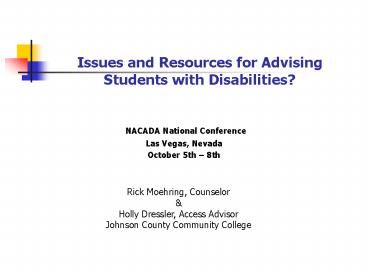Issues and Resources for Advising Students with Disabilities - PowerPoint PPT Presentation
1 / 9
Title: Issues and Resources for Advising Students with Disabilities
1
Issues and Resources for Advising Students with
Disabilities?
- NACADA National Conference
- Las Vegas, Nevada
- October 5th 8th
Rick Moehring, Counselor Holly Dressler,
Access AdvisorJohnson County Community College
2
JCCCs Access Services
- 70 - Attention Deficit/Hyperactivity
- 6 - Autism
- 14 - Developmentally Delayed
- 33 - Deaf/Hard of Hearing
- 15 - Head Injury
- 107 - Learning Disability
- 25 - Medical Disability
- 22 - Physical Disability
- 48 - Psychiatric Disability
- 1 - Speech Impairment
- 3 - Temporary Disability
- 1 - Tourette's Syndrome
- 11- Visual Impairment/Blind
- ----------
- 356
3
Advising Issues
- Career Exploration
- Scheduling Timing/location
- Regular check-ups
- Communication
- Safe Place
- Normalize Experience
- Parent Involvement
- Case worker Involvement
- Take extra time
4
Resources
- DO-IT Disabilities Opportunities
Internetworking with Technology,
www.washington.edu/doit/ - Research
- Training materials
- MOAHEAD Transition Workbook
- Disability Information
- Transition information for students with
disabilities - AHEAD - Association on Higher Education and
Disabilities, www.ahead.org - Research
- Conferences
- Journals
5
Successful Partnerships
- Get to know DSS
- Visit Disability Services Offices on your campus
- Get brochures
- Find out the location
- Familiarize yourself with their processes
- Get on a first name basis
- Get the campus community to see you as a team
- Administration
- Faculty
- In-service
- Presentations
- Staff Meetings
- Professional Development
- Communicate Openly
- Dispel myths
- Discuss turf
6
Opportunities to Collaborate
- Determine appropriate classes
- Advocate for students
- Work with student on behavior issues (Student
Code of Conduct) - Offer support/resources for a student struggling
in class - Transferring to another school
- Problems adjusting to the campus
- Are internships available in this major
- Study abroad opportunities
- Campus Involvement
- Classroom dilemmas
- Transition Issues
7
Trends and Statistics
- The types of disabilities reported by these
students were - Learning disabilities - 45.7
- Mobility or orthopedic impairments - 13.9
- Health impairments - 11.6
- Mental illness or emotional disturbance - 7.8
- Hearing impairments - 5.6
- Blindness and visual impairments - 4.4
- Speech or language impairments - 0.9
- Other impairments - 9.1
- Source An Institutional Perspective on Students
with Disabilities in Postsecondary Education,
National Center for Educational Statistics,
Postsecondary Education Quick Information System,
August 1999
8
Trends and Statistics
- 6 - Undergraduate students identified as
having disabilities Students with disabilities
were more likely to enroll in 2 yr. colleges vs.
4 yr. colleges.Representation in Postsecondary
Education - 63 - students with disabilities enrolled in
postsecondary education 2 yrs after high school - 72 - students without disabilities enrolled in
postsecondary education 2 yrs. after high school - 42 - of students with disabilities enrolled in
4-year schools. - 62 - of students without disabilities enrolled
in 4-year schools. - 16 - students with disabilities earned
bachelor's degree - 25 - students without disabilities earned
bachelors degrees
9
Michael is a 28 year old new student who has not
been in school since high school. An injury four
years ago resulted in a broken neck and he gets
around campus with an electric chair. He has
entry level academic skills, but no real career
plan. He has limited use of his hands. He is
coming by your office in April to plan for Fall
classes What questions might an advisor who
has not worked much with students with
disabilities have concerning working with Michael?































